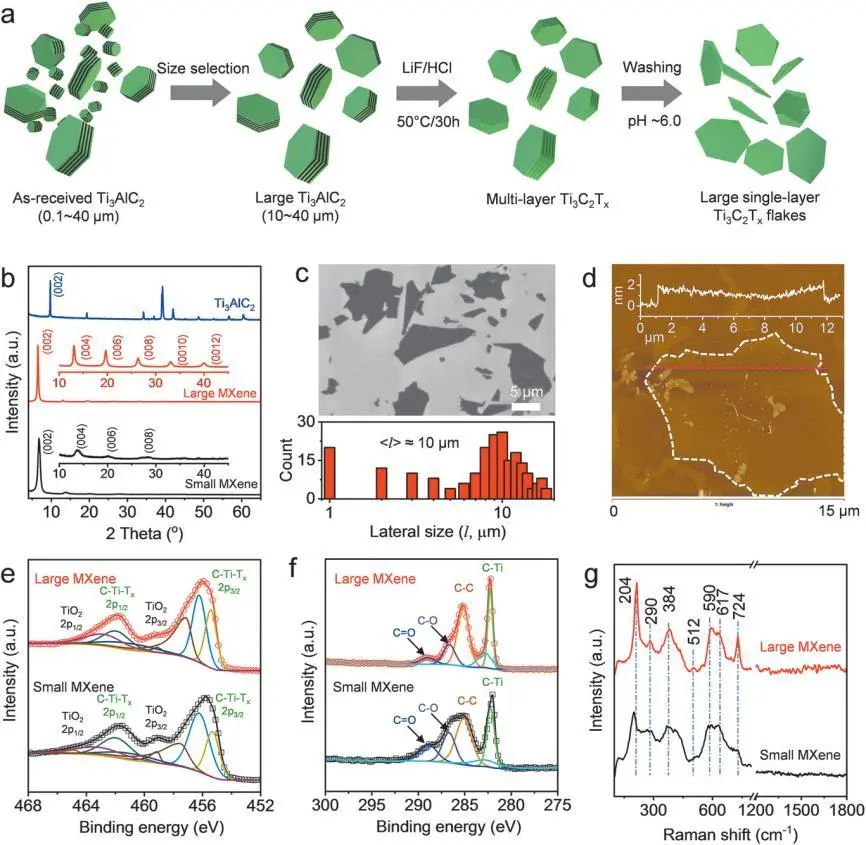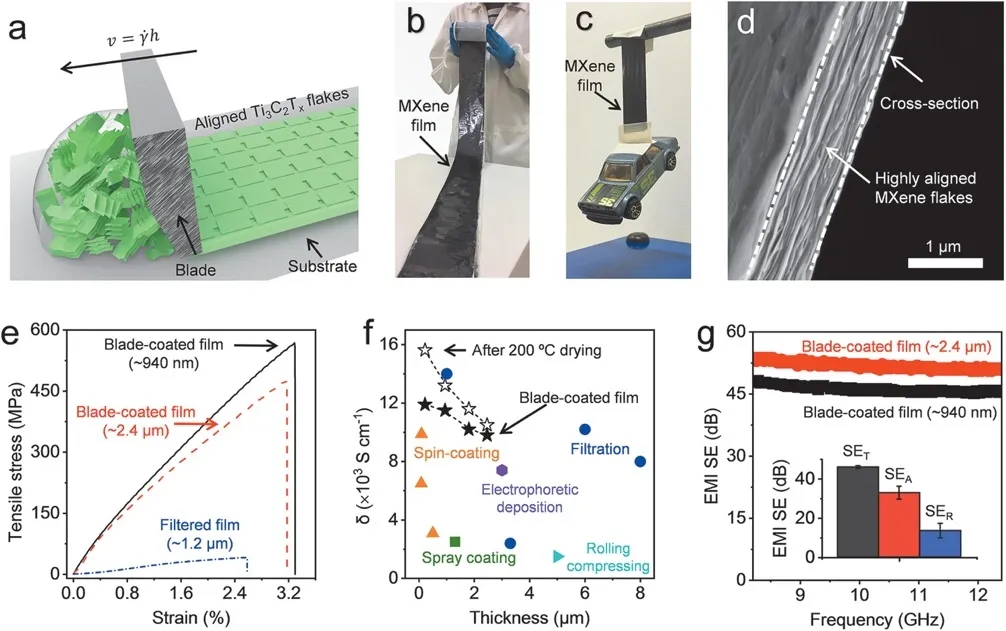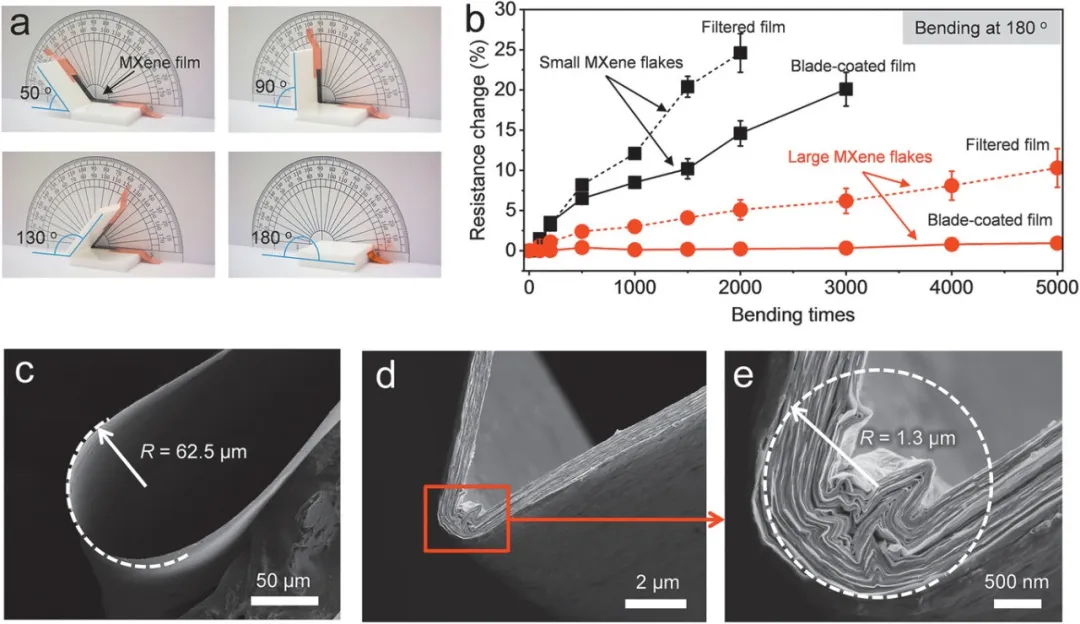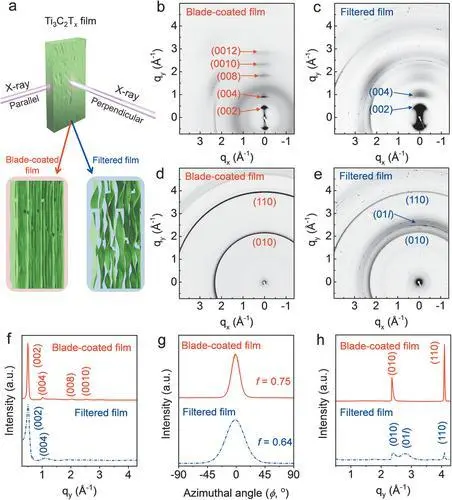
hotline:
17715390137
Tel/Wechat:
18101240246 (Technology)
0512-68565571
Email:mxenes@163.com (Sales Engineer)bkxc.bonnie@gmail.com
Scan the code to follow or search the official account on WeChat:
2D Materials Fronrier After paying attention,
click on the lower right corner to contact us,
Enter enterprise WeChat.
Professional Services Online

Guide
The two-dimensional Ti 3 C 2 T x film has high strength and electrical conductivity. However, due to the small size and relatively poor arrangement of the sheet during the solution-based processing, it is difficult to separate the single MXene sheet The excellent performance is converted into a macro-scale film. This paper introduces a scalable method for preparing pure MXene films with large arrays, high strength, and high conductivity. The authors have demonstrated that the use of large-size MXene films and a scalable blade coating process can achieve high strength and enhanced conductivity of pure Ti 3 C 2 T x MXene films.
Key words
MXene film, orientation, scalable manufacturing, self-supporting

Figure 1. Preparation and characterization of large-size MXene tablets
Background introduction
1. Why study self-supporting MXene film?
The scalable processing of nanomaterials into individual films with high electrical conductivity and high mechanical properties is essential for diversified applications, including applications in flexible electronics, such as supercapacitors, electromagnetic interference (EMI) shielding, sensors and actuators .
To use functional nanomaterials to produce films with high conductivity and high mechanical strength, one of the key challenges is to find nanomaterials with inherently high strength and conductivity. MXenes, a growing family of two-dimensional nanomaterials, whose general formula is Mn + 1XnTx (n = 1-4) is a promising material for the manufacture of strong conductive films.
2. The development and challenges of MXene film
For the assembled pure MXene film, the tensile strength value has not been proved to be higher than 120 MPa. In order to improve the tensile strength of pure MXene film, aramid nanofibers and graphene oxide including polyvinyl alcohol, rubber, cellulose nanofibers, bacterial cellulose and other materials have been used to manufacture MXene-based composite films. These additives greatly improve the connection between MXene sheets, resulting in improved mechanical properties relative to pure MXene films. However, because these adhesives are usually inserted between MXene sheets, the conductivity of the composite film is two orders of magnitude lower than that of pure MXene films. These existing work clearly illustrate the challenges in maintaining high electrical conductivity while increasing the strength of the MXene film.
Recently, Chen et al. Found that the treatment of Ti3C2Tx dispersion with about 0.1M hydrochloric acid solution triggers the self-assembly of MXene flakes. As a result, after HCl treatment, the Ti3C2Tx film showed high conductivity (up to 10400 S cm-1), and the tensile strength improved from ≈20 to 112 MPa. This method demonstrates the potential for producing high-strength pure MXene membranes.
In the case of pure MXene films, the lower conductivity and tensile strength values are partly due to a combination of factors, including smaller MXene flake size (transverse dimension of a few hundred nanometers), MXene due to ultrasonic treatment Defects on scales, film due to imperfect flaky and irregular dispensing. During solution processing, controlling the size, orientation, and bulk density of MXene sheets is critical to improving the overall performance of pure MXene films. However, there is currently no research investigating the effect of flake size and MXene flake orientation on its macrostructural properties.

Figure 2. Blade blade coating process and performance characterization
core content
In order to meet these challenges, recently, Joselito M. Razal of Deakin University in Australia and Yury Gogotsi of Drexel University and others published articles entitled "Scalable Manufacturing of Free-Standing, Strong Ti3C2Tx MXene Films with Outstanding Conductivity" on Advanced Materials. . Jizhen Zhang is the first author of this article.
This article shows a high-performance self-supporting MXene film. This technology uses blade coating to increase the strength and conductivity without using any binders or additives, and its strength is higher than that of pure MXene membrane (10-20 MPa) made by vacuum-assisted filtration without any treatment. 30 times, about 5 times higher than MXene film treated with HCl, and twice higher than the best MXene composite film.
After vacuum drying at 200 ° C for 6 hours, the conductivity value of the film produced by the blade coating method reached ≈15100 S cm-1, which is the highest published value of MXene film to date . In practical applications, for X-band (8.2-12.4 GHz) 940 nm thick films, high conductivity provides excellent EMI shielding performance of 47.9 dB.
Here, the author has demonstrated that the use of large-size MXene film and a scalable blade coating process can achieve high strength and enhanced conductivity of pure Ti3C2Tx MXene film . First, select the large MAX phase in advance, and then adjust the etching conditions to synthesize the MXene sheet with high aspect ratio. In addition, the proper rheological properties of the formation and dispersion of liquid crystal MXene align the flakes under shear force, resulting in highly oriented flakes along the plane of the blade coating film.
These combined indicators can produce highly conductive independent films with record tensile strength (± 570 MPa), Young‘s modulus (± 20.6 GPa), and ± 15 100 S cm-1 (after annealing treatment). The positive effects of large MXene sheets and their alignment to mechanical properties and electrical conductivity are expected to enable a range of applications based on highly conductive pure MXene films such as EMI shielding, energy storage, and printed electronics.

Figure 3. MXene film bending performance test
a) Photos of a piece of MXene film (1 cm × 4 cm) undergoing a bend test. The film is mounted on two insulating poly (tetrafluoroethylene) blocks which can be repeatedly bent at various degrees. Conducting copper tapes were used at both ends of the sample to establish the electrical connection.
b) Changes in resistance of MXene film after fully folded (180 °) for up to 5000 cycles. Filtered and blade‐coated films that are made from small flakes are broken after bending for ≈2000 and ≈3000 cycles, respectively.
c) SEM image of blade coated film made from large flakes folded at 180 ° forming a radius of ≈62.5 μm.
d) Low‐magnification
e) high‐magnification (e) SEM images of a blade coated film made from large flakes bent at an extremely small radius of ≈1.3 μm.

Figure 4. Small-angle and wide-angle XRD test of MXene film
a) Schematic illustration of the positions of the X‐ray beam (parallel and perpendicular to the MXene film plane) during small‐ and wide‐angle X‐ray scattering (SAXS / WAXS). The bottom shows the predicated microstructure and orientation of MXene flakes within films produced by blade coating and vacuum‐assisted filtration.
b, c) SAXS / WAXS patterns of blade‐coated films (b) and filtered films (c) prepared using large MXene flakes when the film plane is parallel to the X‐ray beam.
d, e) SAXS / WAXS patterns of blade‐coated films (d) and filtered films (e) prepared using large MXene flakes when the film plane is perpendicular to the X‐ray beam.
f) Diffractograms of the film samples obtained by integration of SAXS / WAXS 2D spectra shown in (a) and (b) along the qy direction.
g) Azimuthal plot for (002) peaks marked in (a) and (b) in azimuth range of −90 ° and 90 °.
h) Diffractograms of MXene films obtained by integration of (c) and (d) along the qy direction.
Source of information:
Disclaimer: Purely academic, non-commercial use, if there is any infringement, please contact us immediately, we will delete it as soon as possible to protect the intellectual property of the original author

| Reminder: Beijing Beike New Material Technology Co., Ltd. supplies products only for scientific research, not for humans |
| All rights reserved © 2019 beijing beike new material Technology Co., Ltd 京ICP备16054715-2号 |